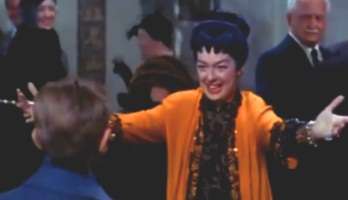Auntie Mame

Auntie Mame and its sequel Around the World with Auntie Mame were novels written in the 1950s (Auntie Mame came out in 1955, and Around the World in 1958) about the adventures of a young boy being raised as the ward of his eccentric, impulsive, wealthy aunt. The author, Evan Tanner, wrote under the pseudonym of "Patrick Dennis", and used that name for his narrator.
The first novel was adapted into a 1956 play by Jerome Lawrence and Robert Lee, which appeared on Broadway with Rosalind Russell starring in the title role. This was itself adapted into a 1958 film (also starring Russell). In 1966 Jerry Herman turned the story into The Musical Mame (starring Angela Lansbury), and this version in turn was made into a 1974 film (starring Lucille Ball).
- First-Person Peripheral Narrator: The main story is encased in a "frame" narrative, in which Patrick, now grown and married, tries to placate his wife with highly edited tales of his aunt, who is the main character of this stories.
- A Friend in Need: If one of Mame's pals is in trouble, or needs help, Mame's right there. Of course, things don't always go as planned...
- Funetik Aksent
- Heterosexual Life Partners: Auntie Mame and her best pal, stage star Vera Charles.
- Lady Drunk: Mame and Vera (and sundry other chums of Mame's) are very fond of wetting their whistles, usually with something like a martini...or two, or three.
- Maiden Aunt: Mame is very much a subversion of this.
- Nephewism: The narrator, "Patrick Dennis," is Mame's nephew.
- Only Sane Man: Patrick, usually, when Mame goes on one of her kicks.
- Paper-Thin Disguise: Auntie Mame's idea of going incognito (as when visiting her nephew at school) makes her more conspicuous than she would be normally.
- The Roaring Twenties: The story starts a few years before the Great Crash of 1929, and Mame is riding high on stock profits.
- The Show Must Go Wrong: At one point after the 1929 Crash, Mame's finances are so low that she has to take a minor part in one of Vera Charles' stage plays. It doesn't work out well, although the reasons differ between the book and the stage versions.
- Sleep Mask: Auntie Mame is wearing one when Patrick bursts into her room to show her his new toy airplane.
- Smug Snake: After Mame's wealthy husband dies unexpectedly, she is courted by many men, some of whom fit this trope remarkably well. One example is her late husband's cousin, who is like an evil version of him.
- Upper Class Twit: Gloria Upson, who acts like stepping on a pink pong ball is a spectacular story.
- Vitriolic Best Buds: Mame and Vera are great friends, who nonetheless snap at each other and quarrel repeatedly.
- This dynamic also applies between Mame and another of her old friends, whom she runs into in Venice.
The various adaptations provide examples of:
- Dreaming of a White Christmas: Immediately after the "We Need a Little Christmas" number in the 1974 film, it starts snowing (not entirely unheard-of for New York City in November, but still...)
- Foreign Queasine: At one point Mame serves the Upsons pickled rattlesnake.
- Hollywood Costuming: The first film had the characters dressed in styles much closer to then-current ('50s) dress than the '20s and '30s.
- Order Versus Chaos
- Pretty in Mink: Several furs are work, such as Mame loaning Agnes a brown mink wrap and Gloria Upson wearing a sheared fur jacket and later a white mink stole.
- T-Word Euphemism: In the 1958 film.
"What's that, Auntie Mame?"
"That's a B, dear. The first letter in a seven-letter word that means your late father."
- Timeshifted Actor: Patrick.